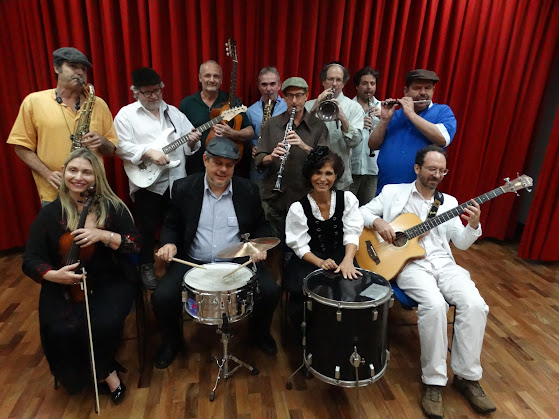A Short documentary about Rancho Praca Onze,
by journalists Rose Tabak and Bernardo Tabak,
Szpilman Orchestra in Poland, Ostrowiec , ca. 1905, which inspired our group.
Our co-founder and musical director Ricardo Szpilman, and his two sons, are one of the few descendants of this family keeping the musical heritage.
Władysław Szpilman (1911-2000), featured in Polanski's "THE PIANIST", a member of the family who stayed in Poland and survived the Holocaust
Praça Onze, ca. 1930, the main square, close to where most of jews in Rio lived between the 20's and the 50's. The neighborhood was part of the so-called "Little Africa", with a huge population of blacks who started occupying the region, particularly after the official end of slavery in Brazil, in 1988.
Photo that possibly portrays Tia Ciata, the main person behind the creation of Carioca Samba, who lived in Praca Onze. Her house was also a place for religious and cultural activities.
https://en.wikipedia.org/wiki/Tia_Ciata
Rancho Praca Onze in a Carnival party at Hebraica Club, in 2016
At the "condo" in which the Rancho Praça Onze founding members' ancestors and relatives lived, from the 1930s to the 60s.
The Main Village - Rua Clementino Fraga 63
This village on Praça Onze, right behind the Calouste Gulbenkian Arts Centre, with around 60 houses, is one of the last architectural and historical remnants of the large wave of Jewish immigrants who settled and lived in downtown Rio de Janeiro, between the years 1925 and 1965, approximately. http://youtu.be/miyKYhMjf2E
This region, humorously called "Yidishe Avenid", was also part of Little Africa, whose central point was Casa da Tia Ciata, where samba in Rio was practically born.
Leonardo Fuks' grandfather Moszko arrived in Rio in 1934 and only in 1935 was he able to bring his wife Fajga, with with their children Szmul and Mordka
In the childhood, mosto of the jewish kids would watch the "sambas" that took place in the streets and in Praça Onze, where today the monument of Zumbi dos Palmares is located.
The village had an illustrious resident, Tia Carmen (Yara da Silva: 1878-1988), "mother of saint", member of the Baianas da Mangueira group, religious and cultural partner of Tia Ciata.
Here, the families of the four group founders lived until the 50's or early 60s, when they moved to the South Zone.
The only member of this thriving Jewish community still living in and around the village, when the group was founded was Mr. Maurício Bemkes, the friendly Pinduca, and his small family.
Pinduca passed away some years ago, as his son, and now only his daughter and grand-daughter live there.
We had the company and collaboration of journalists Bernardo Tabak and Rose Esquinazi, who wrote articles and records on this fascinating subject, which has already been the subject of a few articles and a documentary
http://www.youtube.com/watch?v=gelIjC30c8w&feature=share&list=PLDkWUYfSFGJuPmMj8jGe1tkA2ZlMbI3kW&index=1















